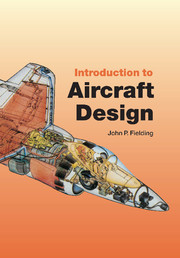Book contents
- Frontmatter
- Contents
- Preface
- Acknowledgements
- 1 Introduction
- 2 Why should we design a new aircraft?
- 3 Why is it that shape? – Civil aircraft
- 4 Why is it that shape? – Other types
- 5 What's under the skin? – Structure and propulsion
- 6 What's under the skin? – Airframe systems
- 7 What's under the skin? – Avionics, flight control and weapon systems
- 8 Why do aircraft cost so much?
- 9 What help can I get? – Bibliography and computer-aided design
- 10 The shape of things to come – Should the project continue?
- 11 What can go wrong? – Some lessons from past aircraft projects, and a glimpse into the future
- Appendix A Useful aircraft design data
- Appendix B A–90 parametric study. Example – the A-90 500-seat airliner
- Appendix C The prediction of aircraft reliability and maintainability targets
- References
- Index
8 - Why do aircraft cost so much?
- Frontmatter
- Contents
- Preface
- Acknowledgements
- 1 Introduction
- 2 Why should we design a new aircraft?
- 3 Why is it that shape? – Civil aircraft
- 4 Why is it that shape? – Other types
- 5 What's under the skin? – Structure and propulsion
- 6 What's under the skin? – Airframe systems
- 7 What's under the skin? – Avionics, flight control and weapon systems
- 8 Why do aircraft cost so much?
- 9 What help can I get? – Bibliography and computer-aided design
- 10 The shape of things to come – Should the project continue?
- 11 What can go wrong? – Some lessons from past aircraft projects, and a glimpse into the future
- Appendix A Useful aircraft design data
- Appendix B A–90 parametric study. Example – the A-90 500-seat airliner
- Appendix C The prediction of aircraft reliability and maintainability targets
- References
- Index
Summary
General
This Chapter discusses the costs of buying and operating civil and military aircraft. The former costs are termed acquisition costs for both classes of aircraft, whilst the latter are termed operating costs for civil aircraft, and life-cycle costs for military aircraft (LCC). The acquisition costs are included as important elements of both operating and life-cycle costs. The costs associated with aircraft reliability and maintenance are significant contributors to operating and LCCs, and design to reduce these costs is outlined at the end of this chapter.
Acquisition costs (the costs of buying, or acquiring the aircraft)
The reasons for high aircraft acquisition costs
The main reasons are:
(i) High performance requirements – Civil and military aircraft operations are competitive, hence each new type is required to show improvements relative to existing aircraft. It is therefore necessary to undertake extensive research programmes and also to incorporate customer/operator refinements, which imply complexity.
(ii) Safety considerations – Civil and military aircraft have, rightly, very stringent safety requirements which must be proved before the aircraft enters service. Extensive proving and testing is required and there is a need for added complexity so that failure of individual components or systems can be tolerated. An aircraft has to continue functioning safely even after a failure has occurred. This applies to both hardware and software.
[…]
- Type
- Chapter
- Information
- Introduction to Aircraft Design , pp. 109 - 128Publisher: Cambridge University PressPrint publication year: 1999

